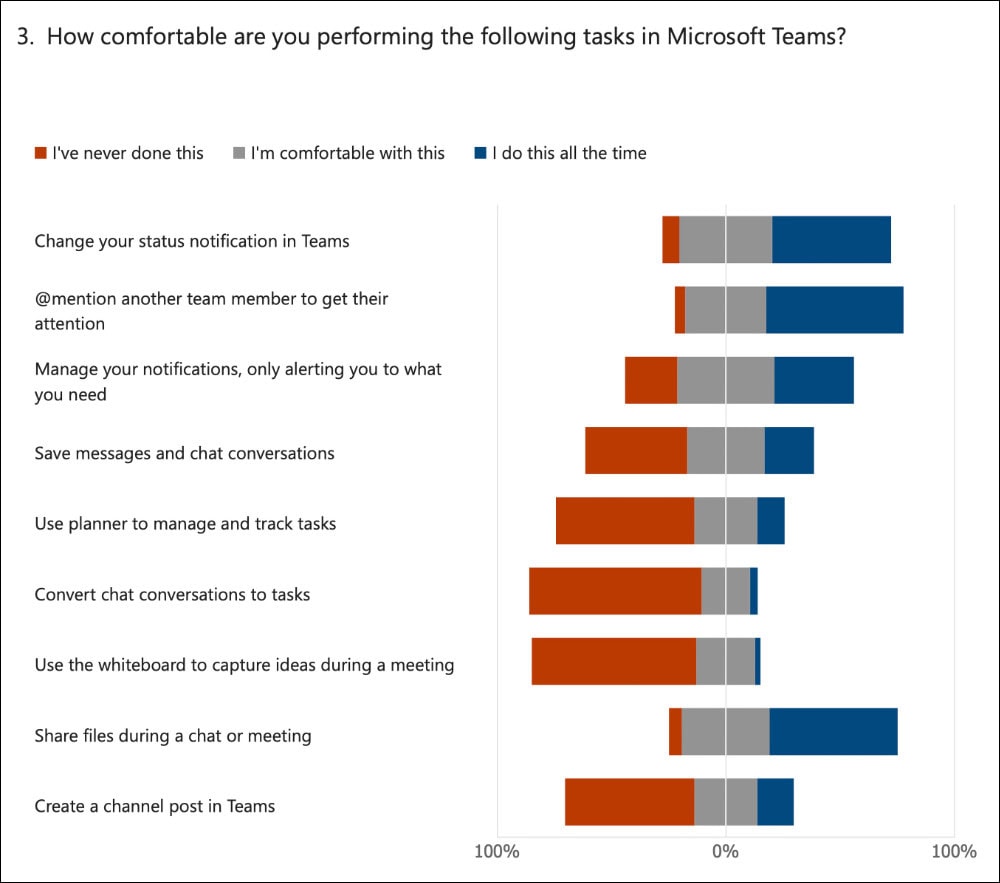
Filed under: Collaboration and social, Digital employee experience, Digital workplace, Microsoft 365
Digital literacy in a workplace context covers a broad range of skills and behaviours, from foundational skills that are often taken for granted (but shouldn’t be!) through to leading-edge, rapidly-evolving expertise.
From simple to complex, digital workplace skills include:
- receiving, writing and managing email
- managing files, belonging to individuals or teams
- creating (and co-creating) documents
- conducting successful searches
- collaborating with others
- working effectively within a team
- participating in, or running projects
- working remotely
- using personal digital devices (such as phones or tablets)
- addressing records and information management requirements
- utilising generative AI
This breadth of required expertise leads to two key questions:
What skills and behaviours do employees need? The answer to this can be found in taking a competency-based approach to digital literacy, that starts by determining key ‘scenarios of use’ and then determines the key concepts and required skills.
What digital skills do employees currently have? Organisations then need to determine the gap between current and required skills in order to create an effective skills uplift program. Using that competency-based approach provides a practical way forward that can be undertaken by firms of all sizes.
Conduct a training needs assessment
Competency-based learning provides a framework of practical approaches and activities to build required skills and establish required behaviours. This includes what’s called a ‘training needs assessment‘ (TNA), which provides a baseline view of what skills employees have, and therefore which gaps need to be closed.
The starting point is to determine which skills are required, as outlined in the article Take a competency-based approach to digital literacy. Structure these according to specific ‘scenarios of use’ (such as ‘working with teams’ or ‘managing documents’), acknowledging that different skills will be needed by each staff cohort.
Conducting a training needs assessment need not be an onerous task, and a variety of methods can be used including:
- online surveys or tests
- focus groups
- interviews
In the initial stages of building digital literacy, it won’t be necessary to assess every employee’s skills, just to conduct a broad enough assessment to enable practical change and adoption plans to be designed. That being said, once change programs are underway in earnest, it will be important to conduct comprenhesive before-and-after assessment of all employees, to ensure that required skill levels are attained.
What a training needs assessment uncovers

Survey results from an assessment of digital skills relating to MS Teams
In our consulting work, we provided long-term assistance to a technology firm undertaking a major transformation of their digital workplace. A key element of this was establishing new practices in Microsoft 365 that aligned with the needs of service delivery teams, such as sales and technical support.
Having developed a number of “M365 Waves” that identified the skills needed by their team members, we used an online survey to conduct a self-assessment of key digital skills and behaviours. An example of the results is shown above.
What’s immediately apparent are the big differences in digital literacy across a range of activities, even relating to what would normally be considered ‘assumed’ competencies such as posting to a channel in Teams. More broadly, the digital transformation being conducted embedded the use of M365 into service-delivery activities, making gaps around the use of tasks and Planner a significant concern.
Whether related to the use of M365, generative AI or any other digital workplace practice, it’s clear that this type of training needs assessment sheds valuable light on the current state of digital literacy, and where change activities should be focused.
Assess new starters
In the competency-based framework that we use, skills and behaviours are divided into three levels: bronze (everyone should know); silver (most should know) and gold (needed by key users or in specialist situations).
While many organisations conduct change and adoption programs to foster these skills, too often they’re run as a one-off project. New starters, however, will be joining these firms all the time, and they will miss out on this training.
To address this, new starters should complete a digital literacy self-assessment as part of their induction activities. Proactive steps must then be taken to ensure that they quickly gain skills at the ‘bronze’ level, followed up by training in ‘silver’ competencies as they become familiar with their new digital workplace environment.
Make data-driven decisions about digital literacy
The old adage “you can’t manage what you don’t measure” is directly applicable to digital literacy campaigns. Without a clear understanding of what skills and behaviours employees currently have, there’s no way of knowing how big a gap needs to be closed and what training should be provided.
Thankfully conducting a training needs assessment need not be onerous, and even only a proportion of the workforce respond to the survey, a valuable snapshot will quickly be gained that can inform data-driven decisions about digital literacy.
This type of assessment should not be a one-off exercise, as digital literacy requirements will change over time, and new starters will regularly come into the business. Conducting the assessment yearly is therefore recommended, as well as including it in induction processes.





